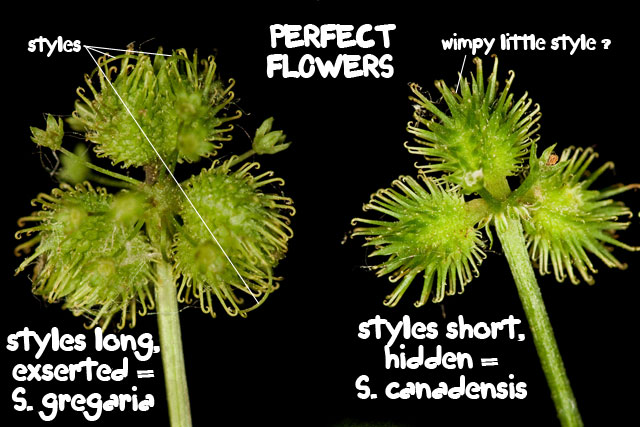 |
 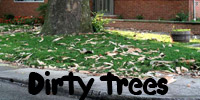 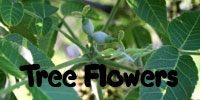 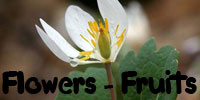 |
Welcome
to bobklips.com, the website of Bob Klips, a plant enthusiast living in
Columbus, Ohio. ..................................................................................................................... Manuka oil!
June 29, 2009. Lucas County,Ohio (more on the emerald ash borer) Manuka (Leptospermum
scoparium, Myrtaceae, the myrtle family) is a New
Zealandish shrub, the source of an oil popular among those who employ
herbal
remedies. According to one
web site promoting its use,
preparations made from manuka leaves have long been used by the Maori
people to cure a variety of ailments such as urinary complaints and
head
colds, as well as as a "febrifuge" (fever-reducer).
The bark is used along with the leaves to concoct a muscle and
joint-soothing salve, or it is or simply chewed as a relaxing
sleep-enhancer. Nowadays, and more widely, a very aromatic concentrated
oil made by steam-distilling manuka leaves and small twigs is sold for
its
antibacterial, antifungal, anti-inflammatory and anti-acne
properties. A major active ingredient is leptospermone.
***Study hint for the upcoming pharmacology quiz: If you don't know the name of a plant-derived chemical, simply take its genus name and add "-one" or some similar cognate at the end. It works every time! Well, not every time really...but every so often at least. Here are some examples: 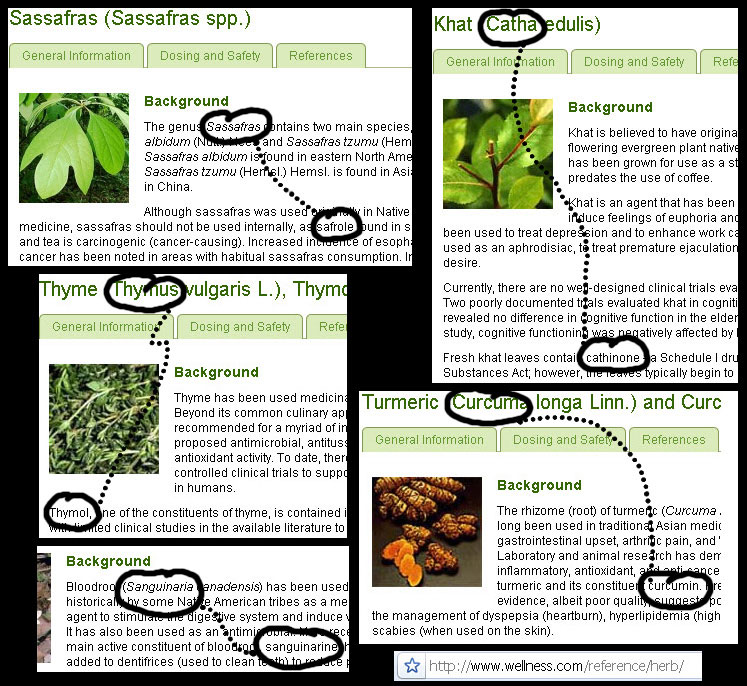 Some
instances of
plant-derived chemicals the names of which are similarly derived.
Manuka oil is also used in aromatherapy. People love manuka oil because it smells like a stressed and dying ash tree! Well, not people maybe, but apparently emerald ash borers do, because manuka oil is a great attractant for detecting the presence of the metalic wood boring (Buprestid) beetle Agrilus planipennis. How do they discover these things? A pad saturated with the oil is used inside sticky traps made of cardboard-like plastic pyramidal cones hung from ash trees in areas where EAB researchers are assaying the abundance of the pests. The traps are purple because purple is the beetle's favorite color. How do they discover these things? This day I had the pleasure of accompanying USDA Forest Service and OSU researchers at the Oak Openings Metropark in Lucas County (northwest Ohio, near Toledo). The sites we visited were low-lying areas, formerly forested, where green ash was predominant. 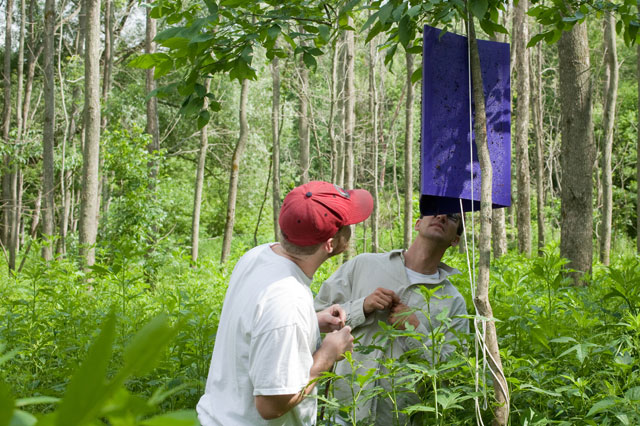 EAB researchers employing aromatherapy. Oak Openings Metropark, Lucas County Ohio. June 29, 2009. The trap at
this
location don't have very
many beetles stuck to it, mainly because the beetles have already "been
there,
done that." Since there are no living ash trees of substantial size
remaining --the
devastation is awful --the emerald ash borer is scarce there now. The
photo below shows the extent of the tree loss.
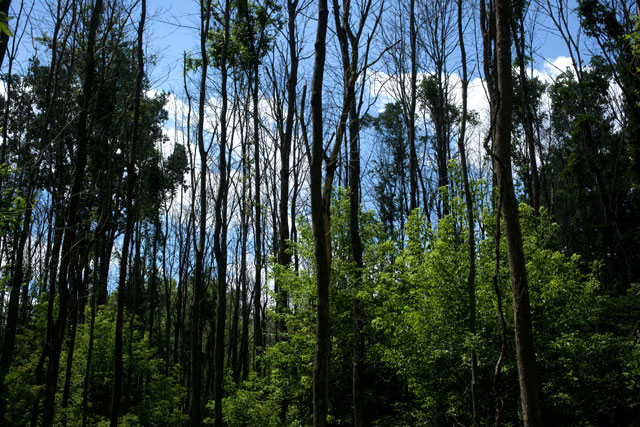 Devastated lowland ash forest in Lucas County, Ohio. June 29, 2009. By contrast, at a study site in central Ohio where the beetles arrived only in the past year or two, they are thriving. The pictures below show a stinky sticky purple trap high up in a tree at the Stratford Ecological Center in Delaware, Ohio. 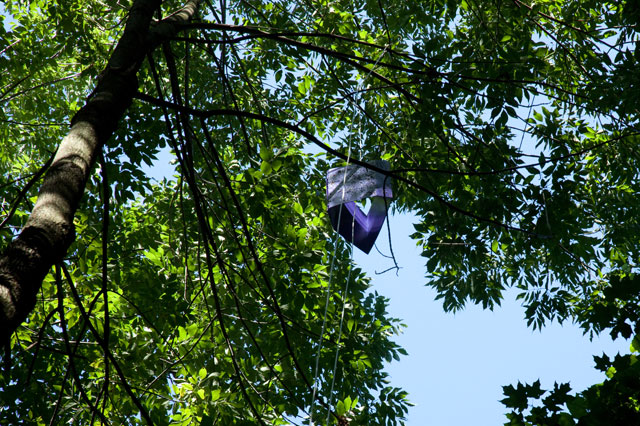 EAB trap at Stratford Ecological Center. July 14, 2009. ...and a bunch of beetles stuck to it. Its interesting they are all on their backs. Do they approach the traps that way, or do they struggle to get free in a manner that ultimately gets them more stuck, on their backs? 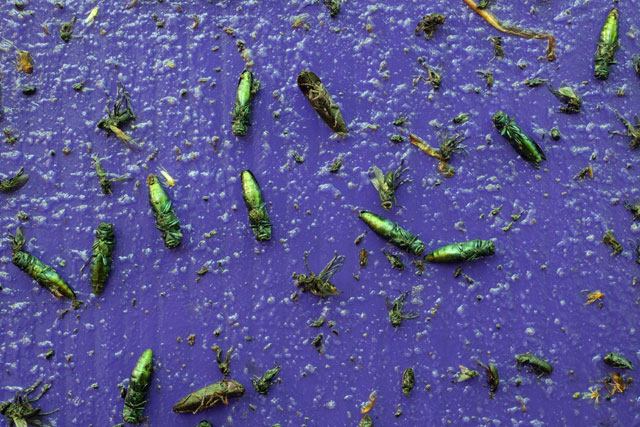 Emerald ash borers on sticky trap at Stratford Ecological Center. July 14, 2009. At Oak
Openings Metropark, the newly
created no-ash openings seem peculiar as they are occupied by
plants normally found in shadier places (as they were
until
quite recently, thanks to the borers). It was nice to see
green
dragon, Arisaemia dracontium, family Araceae, in
fruit.
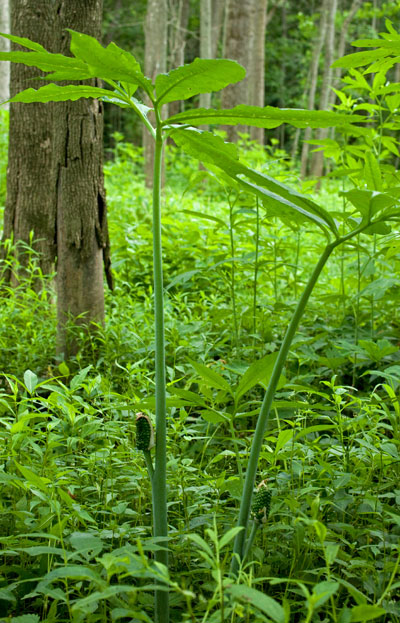 Green dragon at Oak Openings Metropark. June 29, 2009. Green dragon
is in the same genus as Jack-in-the-pulpit (A.
triphyllum). It has a very intriguing leaf complexity
--compound, but divided into two main segments, each
of which is further subdivided into leaflets totalling 7-13 in number.
This composition, termed "pedately divided," is like that of
maidenhair fern (Adiantum pedatum).
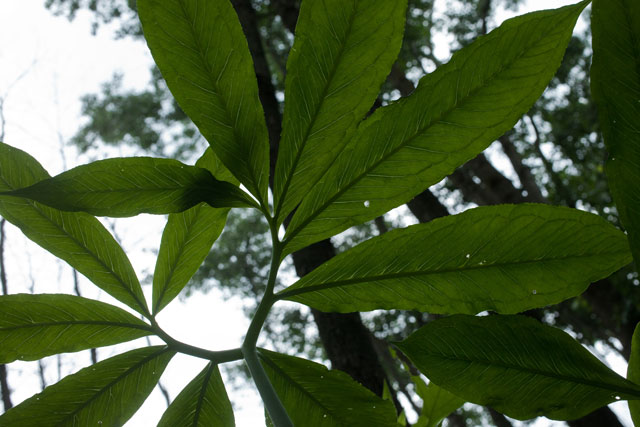 Green dragon leaf. Oak openings Metropark. June 29, 2009. The green
dragon
flowers are arranged
in typical aroid fashion, wherin the flowers are small, and
aggregated over part of a fleshy spike termed the "spadix" (Preacher
Jack is a spadix.) subtended by a large leaflike bract, the "spathe"
(Jack's pulpit is a spathe.). In fruit, it displays a cluster of
berries that will eventually turn orange-red.
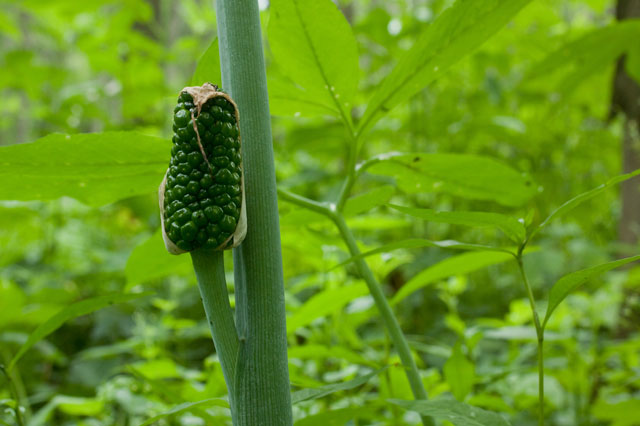 Green dragon young fruit. June 29, 2009. Lucas County, Ohio. Here's what
green
dragon looked like in flower, in a picture taken six weeks and four
years ago.
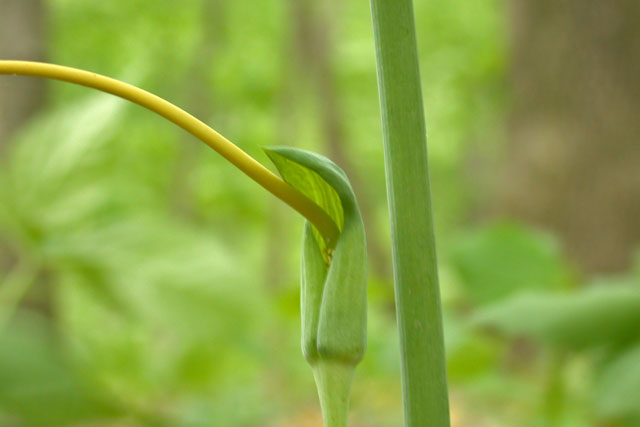 Green dragon as it appeared in flower, mid-May (2004). The wetter
spots are
home to a very
dramatic sedge that looks like a collection of midieval maces.
 From a online weapons shop for reenactors (I hope so anyhow): a collection of midieval maces In the Lupulinae section of the genus Carex, this is either Gray's sedge (Carex grayii) or bladder sedge (C. intumescens). Both species bear a few large wholly pistillate spikes of a globose shape composed of relatively few, relatively large, perigynia (perigynia are the papery-covered single seeded fruit units characteristic of Carex) and a long narrow terminal spike that is entirely staminate. After that is gets confusing. 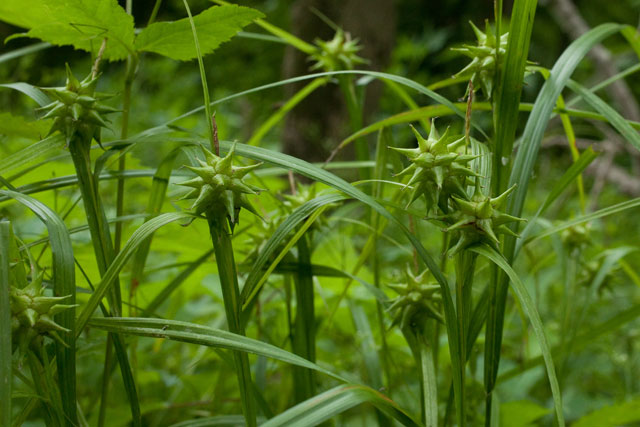 Carex grayii or C. intumescens at Oak Openings Metropark. June 29, 2009. ...confusing
because
while in the field I was sure this was Carex grayii,
a species which which I was long familiar (or at least thought I was).
Another botanist in the group suggested it might be Carex
intumescens
but I rudely scoffed at that idea, thinking is was just the result of
his having inhaled too much manuka oil. It can do that to you.
But
now that it's time to label the photos and present them here,
consultation with E. Lucy Braun through her excellent
1967 Ohio
monocots book casts this identification in a different light. It turns
out there are indeed two mace-headed carices in our area!
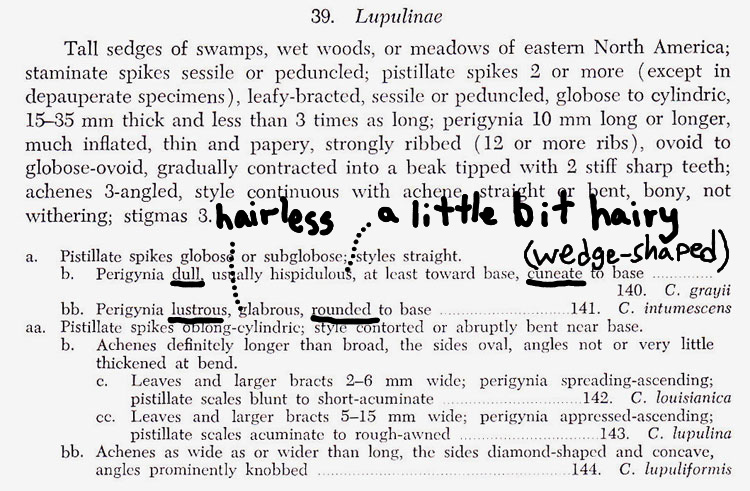 Carex
section lupulinae key in The Monocotyledonae of Ohio.
Arghh. She's
asking
about details of the
pergynium best seen by looking at a specimen through a hand lens, not a
picture of a specimen. But perhaps the "megapixel wars" are good for
something. Here's a zoomed in view of another pic taken today.
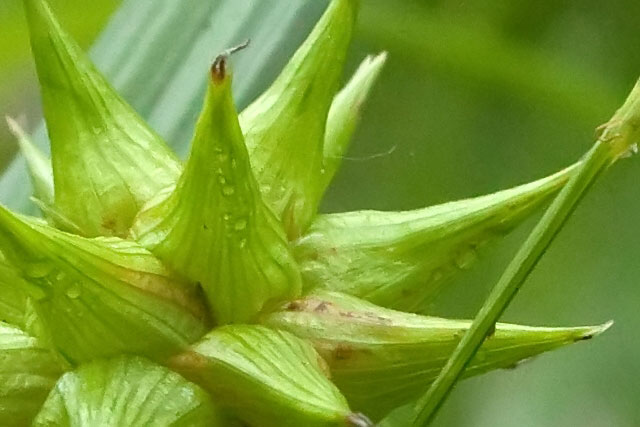 Enlarged portion of sedge head. June 29, 2009. Oak Openings Metropark. While they
don't seem
hairy,
"hispidulous" could be missed in a photo like this. (Moreover --see
below --there are evidently glabrous-ruited forms of C. grayii.)
One thing at least: In this photo, these perigynia do certainly seem
"lustrous" (shiny), not "dull." That pushes it towards C.
intumescens! The situation is made totally worse by examining
carefully the species descriptions in the Ohio monocots book.
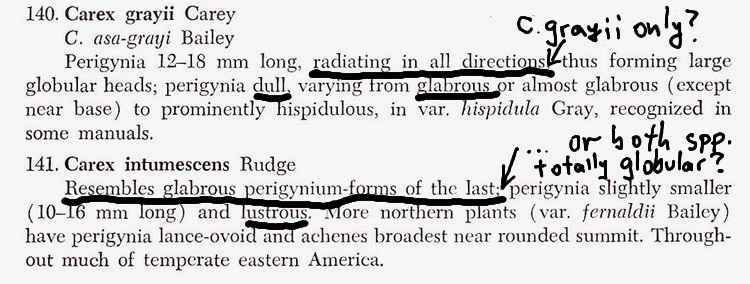 Species descriptions in Ohio monocots book. E. Lucy
tells us that C.
grayii has
perigynia radiating out in all directions. This can be observed in a
picture, and indeed they are. Usually the remarks at this stage in a
key are very species-specific. But there is, sadly, no explicit
complementary refererence to the head shape of C. intumescens,
implying that they are both equally globular. There are
perigynium measurments, making me wish that I had a specimen, but only
for a fleeting instant do I wish that because it always happens that,
if,
say, one species' perigynia are supposed to be 12-18 mm long and the
other's are given as 10-16 mm long, the perigynia on your
specimen will be 14 mm long, squarely within both ranges. Always.
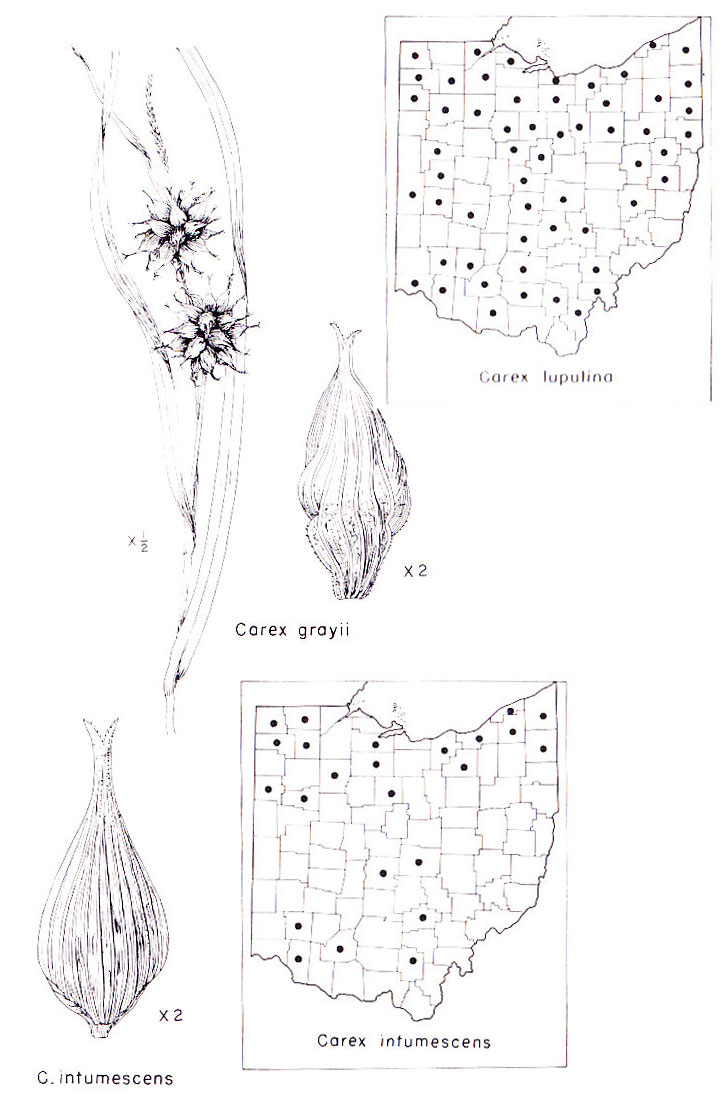 Mace-headed sedge pics and range maps from The Monocotyledonae of Ohio. The range
maps indicate
that either
species is possible in this area. Also, reference to the wonderfully
useful appendix to "Floristic
Quality Assessment Index (FQAI) for Vascular Plants and Mosses for the
State of Ohio,"
by Barbara Andreas, John Mack and James McCormac, 2004, Ohio
Environmental Protection Agency shows that both species have the same
wetness affinity, shade-tolerance, and middling "5" for their Coefficient
of Conservatism (an estimate of the degree to
which a species tends to occur only in specific habitat types.
These are mainly high-quality natural communities similar to those that
existed in pre-settlement times.)
 Portion
of OEPA's Floristic Quality Assessment Index showing pertinent sedge
species.
There
is hope perhaps by turning to another, more modern reference: volume 23
of the Flora of North America (FONA) North of Mexixo --Magnoliophyta:
Commelinidae (in part): Cyperaceae, publishd in 2002 by the Oxford
University Press. In it, A.A. Reznicek states explicity what E. Lucy
Braun hinted at and then backed away from. Yes Virginia, there
is a head-shape
difference between the two species!
"O.K. contestants and Jeopardy fans, the category is 'sedges' for $1000. ...These have the largest perygynia of all Carex." "Buzzzz" "Yes, A.A?" "What is section Lupulinae?!" 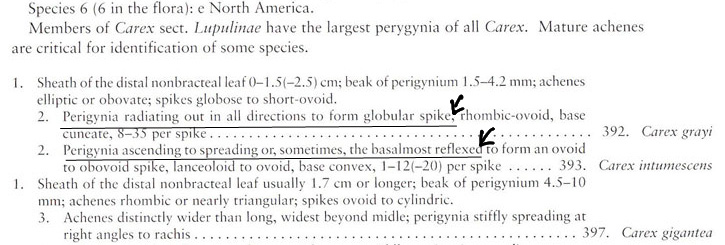 FONA excerpt showing differences betwen two mace-headed Carex species. ...and the
illustrations corroborate that, thankfully.
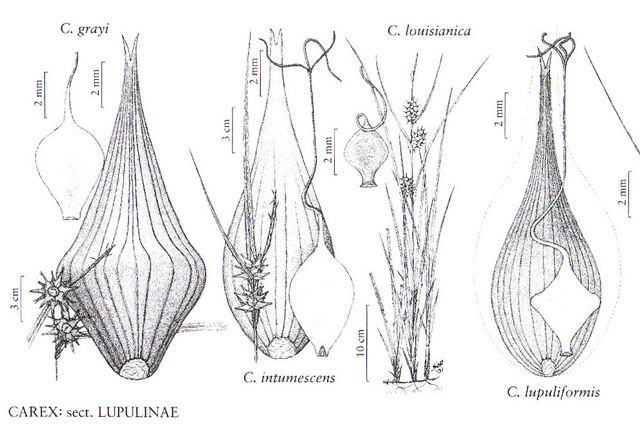 Mace-headed sedge pics from FONA So it seems, provisionally at least, that this mace-headed sedge is Carex grayi after all. If only www.bobklips.com were an nice interactive blog rather than a static website, then someone --perhaps Tim Walters, seen on the far left standing next to the EAB trap in the picture below, who teaches a yearly workshop on sedges and also has dozens of such species growing in his yard/garden--could post helpful sedge identification comments. 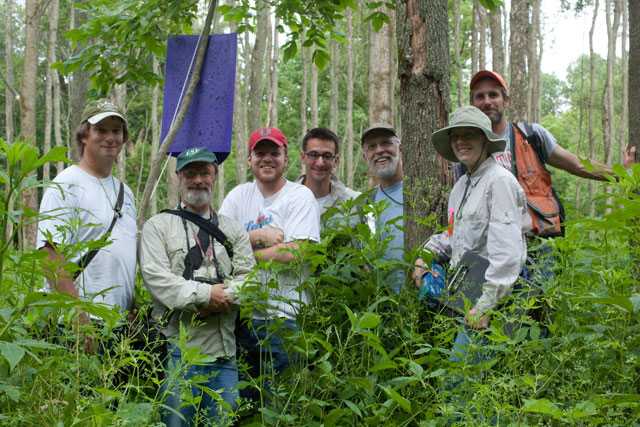 EAB researchers and their enthusastic followers at Oak Openings Metropark, Lucas County, Ohio. Below are images of some of the other woodland plants that are wondering who turned the lights on all of a sudden. Honewort (Cryptotaenia canadensis, family Apiaceae) is especially abundant. 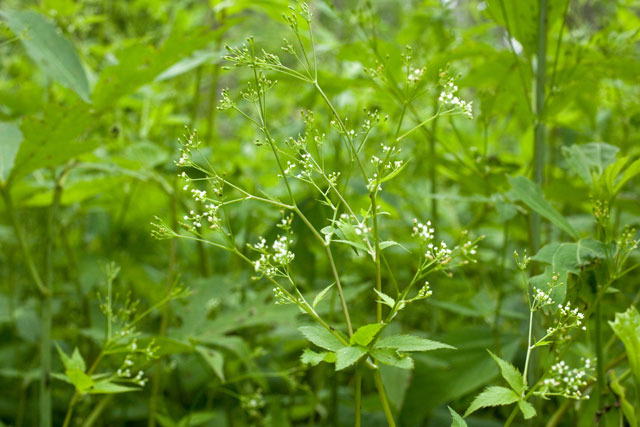 Honewort at Oak Openings Metropark. June 29, 2009. Tall
meadow-rue (Thalictrum
dasycarpum, family Ranunculaceae) is a dioecious (i.e.,
having separate male and female individuals) herb.
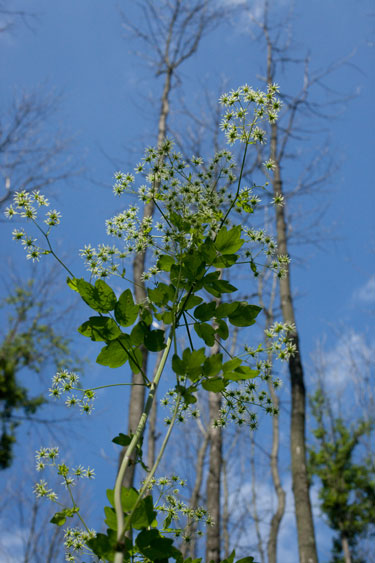 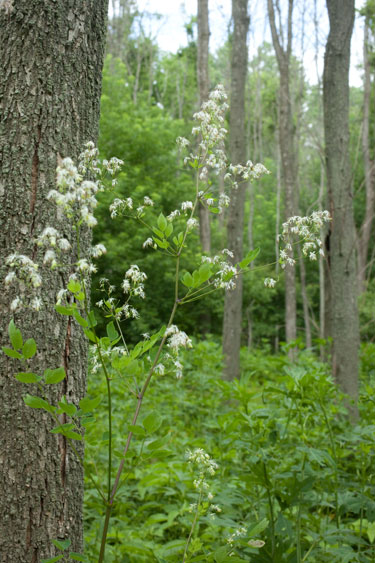 Tall meadow-rue at Oak Openings. June 29,. 2009. Left: Pistillate (female) plant. Right: Staminate (dude) plant. ...closer
views of the
meadow-rue flowers.
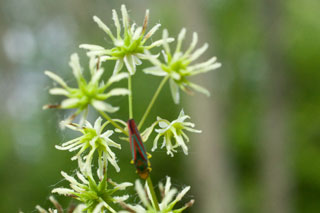 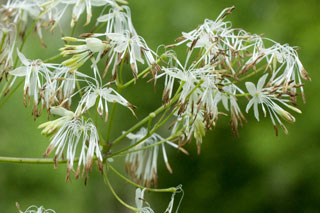 Tall meadow-rue flowers at Oak Openings. June 29,. 2009. Left: Pistillate (female) flowers. Right: Staminate (dude) flowers. 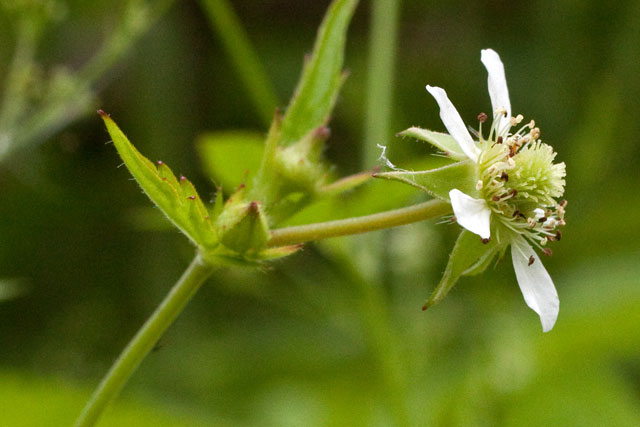 Canada avens flower. Oak Openings Metropark. June 29, 2009. Ohio is home
to five
native species of Rosa
(family Rosaceae), plus six alien ones. Our most
distinctive native is climbing prairie rose, R. setigera.
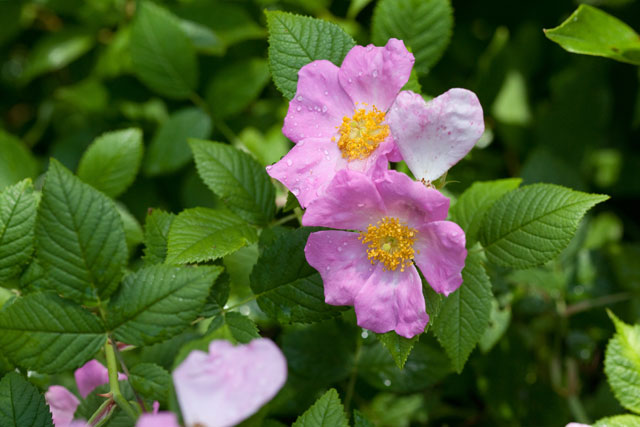 Rose setigera. June 26, 2009. Wyandot County, Ohio. The first
important
subdivision in E. Lucy Braun's excellent rose key in The
Woody Plants of Ohio (OSU Press; 1961, 1989) asks whether or
not the styles are united, forming a column exserted from the throat of
the receptacle. Rosa setigera indeed displays this
trait. Below are images showing the styles of Rosa
setigera and another rose --R. carolina
--that
doesn't have the styles so united.
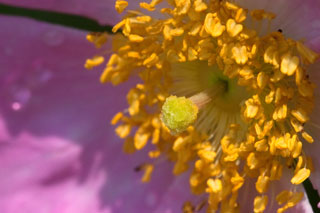 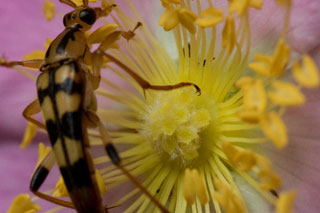 Roses are very stylish! Left: Rosa setigera showing styles united into column. Right: Rosa carolina showing styles shorter, covering throat of receptacle. Rosa setigera is our only native rose with styles of this form. Also, it has large pink flowers, and leaves that are nearly always 3-foliolate (i.e., composed of 3 leaflets). Today the flowers are being visited by (presumably) native pollen-gathering bees (video). Climbing prairie rose and pollen-gathering bee. July 5, 2009. Incidentally,
one of
the nastiest
invasives is also in the small group of roses hacing an exsert column
of styles. This is the dreaded evil multiflora rose (R.
multiflora).
It has small white flowers. This picture, with a hidden spider I didn't
notice until long afterwards, was taken in early June last year.
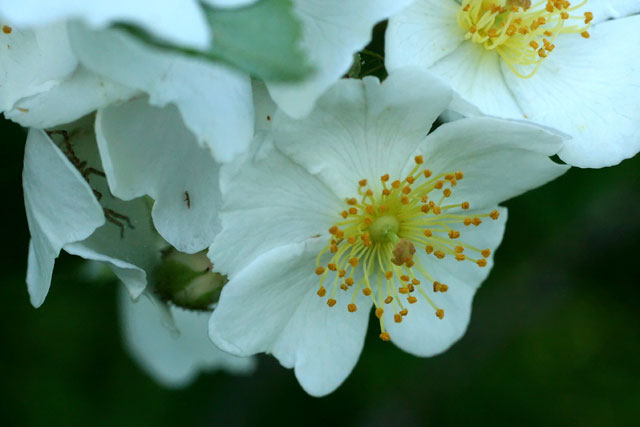 Dreaded evil multiflora rose displaying its style column. June 8, 2008. Marion County, Ohio. Absent
flowers,
malevolent neer-do-well
multiflora rose can be neatly recognized by a vegetative feature:
ragged-edged (fimbriate) stipules. Stipules, paired
leaflet-like stuctures at the very base of a leafstalk, are a hallmark
of
the Rosaceae that is especially evident in roses proper.
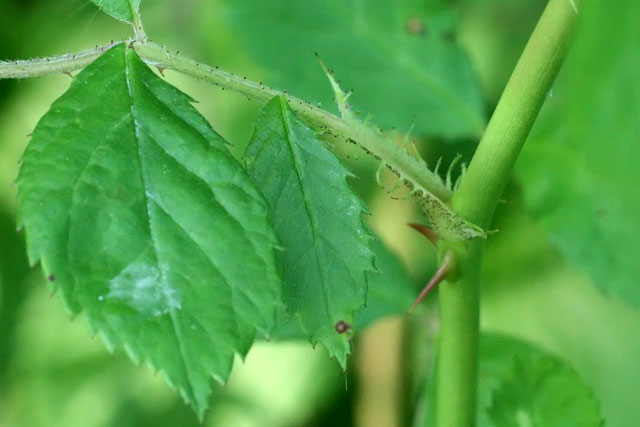 Distinctive fimbriate stipules of terrible demonic multiflora rose. Japanese
honeysuckle
June 23,
2009. Columbus, Ohio
Japanese
honeysuckle (Lonicera
japonica,
family Caprifoliaceae) is a twining or trailing vine that H.A.
Gleason, in the best book ever written (The New Britton and Brown
Illustrated Flora...) aptly describes as "oppresively
abundant; native
of east Asia. May-Sep. Its densely tangled stems are capable of
smothering and destroying shrubs and small trees." Here's a picture of
its twining stems going up a tree a few years ago in northern Ohio.
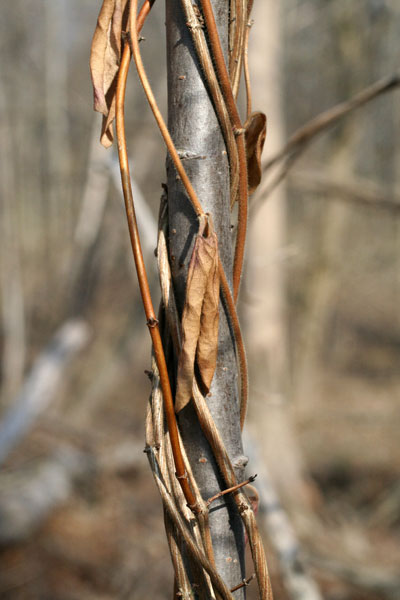 Japanese honeysuckle twining. March 25, 2009. Cuyahoga County, Ohio. The species
is
flowering profusely now in
central Ohio, displaying well the features of its family, the
Caprifoliaceae. The honeysuckle family consists mainly (in our area at
least) of shrubs with opposite leaves. The three predominant local
genera can be distinguished simply on
vegetative traits
alone. Viburnums (genus Viburnum) and honeysuckles (Lonicera)
both have simple leaves. Those of viburnum have serrate
(toothed)
margins (in some species they are lobed as well), whereas honeysuckle's
leaves have entire margins. Contrastingly, the leaves of elderberry (Sambucus)
are pinnately compound (suggestive of ash).
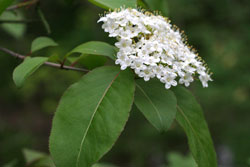 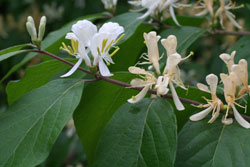 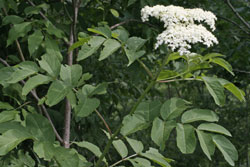 Major genera of the Caprifoliaceae. Left to right: Viburnum, Lonicera, Sambucus. 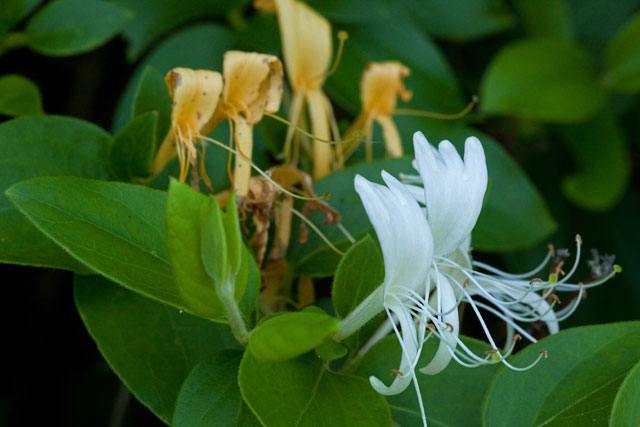 Japanese honeysuckle displaying strongly zygomorphic (bilateral) flower symmetry. Columbus, Ohio. June 23, 2009. A more
detailed view of
the flowers shows
the 5 stamens (per flower) consisting of elongate curved filaments
tipped by oblong-linear anthers (pollen sacs), and the single, slightly
longer and straighter style tipped by a capitate
pollen-receptive
stigma.
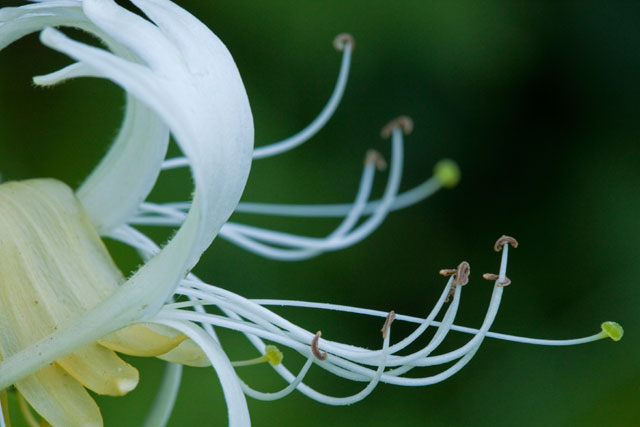 Japanese honeysuckle stamens, style and stigma. June 23, 2009. Columbus, Ohio. An
interesting
honeysuckle trait is the
manner in which the flowers are arranged --in pairs, with each flower
sessile (stalkless), and the ovaries somewhat united. Here's a closeup
of a pair of Japanese honeysuckle flowers taken a few years
ago,
also in central Ohio.
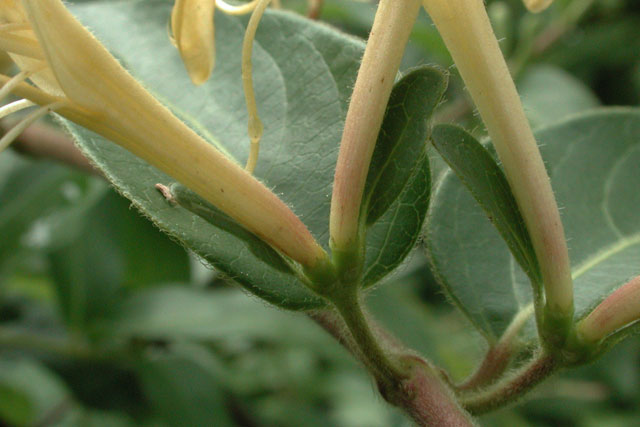 Paired inferor ovaries of Japanese honeysuckle. Aug 30, 2006. Pickaway County, Ohio. After
pollination has
occurred, the
flowers fade to yellow as a signal to pollinating insects that the
flower is "sold out" of nectar, and they ought to look elsewhere for a
meal. The stamens wilt before the style. Perhaps sperm-delivering
pollen tubes are still growing down through the
style on
their way to the egg-containing ovules (future seeds) inside the ovary
(future fruit).
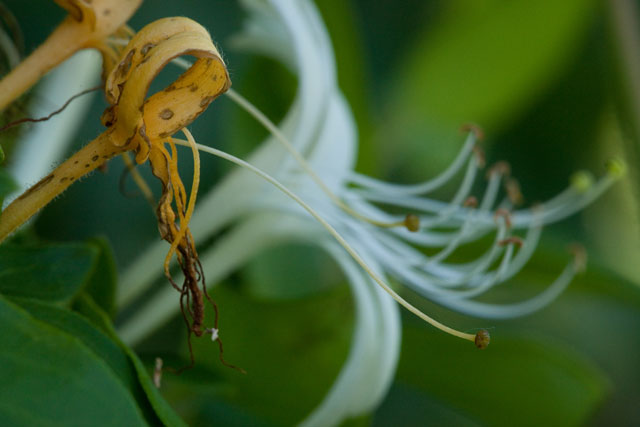 Senescent honeysuckle flower. June 23, 2009. Columbus, Ohio. Extrafloral
nectaries on Vicia
angustifolia
June 21,
2009 at Killdeer Plains Wildlife Area, Marion County, Ohio.
It can be confusing. "Extra" as a word simply means more of something, whereas "extra-" as a prefix signifies something that is outside or beyond. It is in this later sense of "extra" that some plants produce extrafloral nectaries. Vetchling (Vicia angustifolia, family Fabaceae) is an annual vine-like herb that bears alternately arranged pinnately compound leaves that end in a pair of tendrils. The flowers are paired in the upper axils of the leaves. A native of Europe, the plant is established in fields, roadsides and waste places. (What are waste places anyway?) 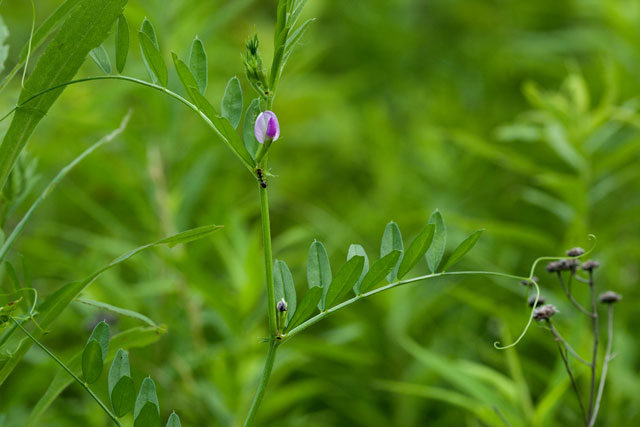 Narrow-leaved vetch in a roadside field (definitely not a waste place though) in Morral, Marion County, Ohio. June 21, 2009. Looking
carefully at
the blossoms, we see several traits typical of the legume (bean)
family.
[Note: In England and elsewhere, beans are called "pulses," and so the Fabaceae is known as the "pulse family." Q: Why did the cardiologist get arrested at the farmer's market? A: She took someone's pulse!] We see a calyx of five fused (connate) sepals, and a corolla that is strongly bilateral with so-called "papilionaceous" (i.e., resembling a butterfly) symmetry. The corolla consists of the five petals that are separate from one another except for a slight fusion at the tips of two of them. Thse consist of a huge upper petal (termed a "banner" or "standard"), and two lateral petals ("wings") held closely together and concealing the two lower partly-fused lower ones (together comprising the "keel"). 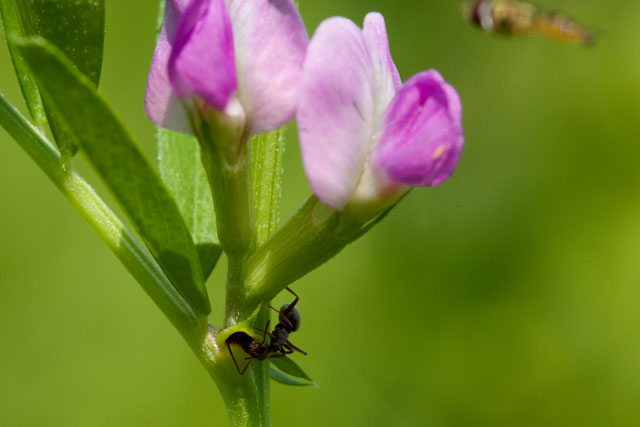 Narrow-leaved vetch. June 21, 2009. Marion County, Ohio. Note also at
the base
of the leaf there is
a dark semi-circular gland
from which an ant is feeding. That is an extrafloral nectary. It is
an accessory nectar-secreting structure that serves not to attract
pollinators as do typical nectaries, which are located in flowers.
Rather, these nectaries promote
visits by ants which (I presume, not knowing whether this particular
case has been studied scientifically) provide the plant with protection
from
herbivores. The relationship is a good example of a mutualistic
symbiosis.
Here's a
video...
Ants
visiting
extrafloral nectaries on narrow-leaved vetch.
June 21, 2009. Morral, Marion County, Ohio. Flower
longhorn beetles tussle on pasture rose
June
21-26, 2009
Killdeer
Plains Wildlife Area, Wyandot County, Ohio
Longhorn beetles (Coleptera; Cerambycidea) are distinguished by having antennae that are as least half as long as, and often nearly as long as, their body. Members of this large family are all plant feeders. Longhorn larvae feast on the solid tissues of plants. Accordingly, they cause serious defects in lumber. Some kill trees; the notorious Asian longhorn for example, is threatening forests in the eastern U.S. and adjacent Canada. However, most contribute beneficially to forest ecology by enhancing the decomposition (recycling) of dead and dying trees. As adults, some species eat nothing, but many feed on flowers, in some cases with great specificity as to species of flower. Thus the family is the most effective of all beetle pollinators. Along the road separating Marion and Wyandot counties in north-central Ohio, pasture rose (Rosa carolina, family Rosaceae) is flowering now, and the longhorns seem to love it. 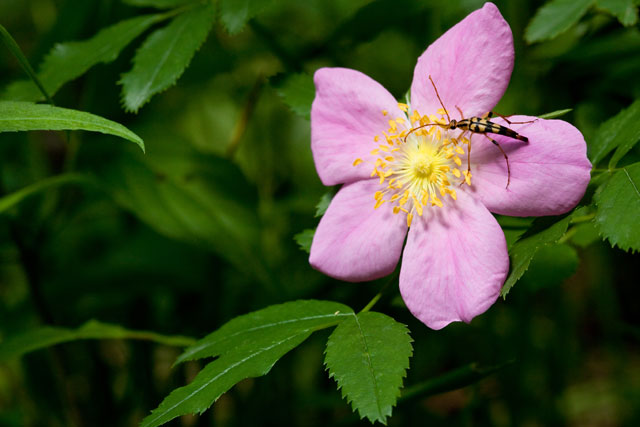 Pasture rose and flower longhorn. June 21, 2009. Wyandot County, Ohio. The beetles
visiting
the rose, munching its pollen and probably also sipping its
nectar
(do roses offer a nectar reward?), are "flower longhorns," i.e.,
members of the subfamily
Lepturinae, that Richard E. White in the Peterson "Beetles"
field guide
points out are often distinguished by having a bell-shaped (narrower at
the front) pronotum.
(He kindly explains that the pronotum is the upper part of the first
thoracic segment, a
segment that, in beetles, is generally prominent, so
that it
may
appear to comprise the entire thorax.)
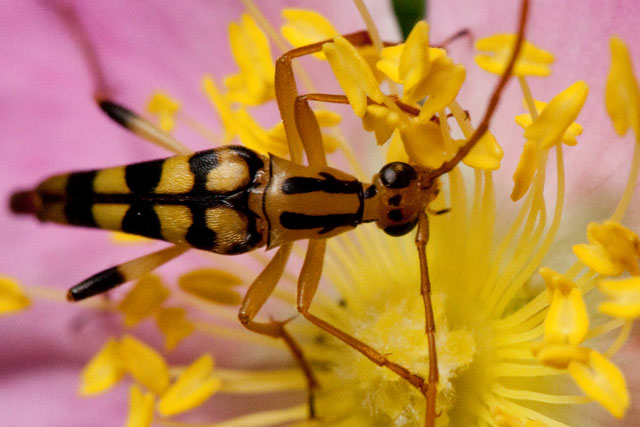 A flower longhorn beetle (Strangalia luteicornis) displays bell-shaped pronotum. June 21, 2009. Wyandot County, Ohio. Thanks to a
pair of
terrific on-line resources --the BugGuide
and the wonderful accurately labeled photos of Tom
Murray on PBase --I was able to pin names on this
species (Strangalia luteicornis) as well as another
one, the "banded flower longhorn," Typocerus velutinus,
that seems to be competing quite successfully for space on the rose
blossoms.
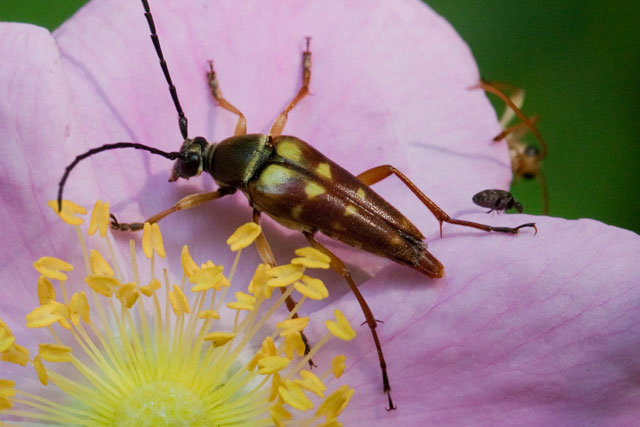 While Typocerus velutinus stands prominently on a rose flower, Strangalia luteicornis peeking from beneath, considers making an ascent. A smaller beetle seems to be saying "I'm getting the heck out of here"! While is may
seem in
the photo below that the beetles are merrily
having lunch together, it might be more of an armed stand-off. The
larger Typocerus persistently
drives the smaller Strangalia off the flower,
but Srangalia keeps coming back, and even
aggressively tries to "jump" the big brute!
 Two flower longhorn species on rose flower. June 26, 2009. Wyandot County, Ohio. Here's a
video showing
the
interaction between these flower longhorns.
Flower
longhorns tussle on rose flower. June 25, 2009. Wyandot County,
Ohio.
Ditdit-dit-ditditdit-dit-ditdit...News
flash!!!
Another
sanicle --S. trifoliata!!!
[dateline:
near Highbanks Metro Park, July 17, 2009]
While merrily snapping some pics of goldenseal fruits (coming soon), it was a pleasure to almost step on ...yay!!...another sanicle!!! 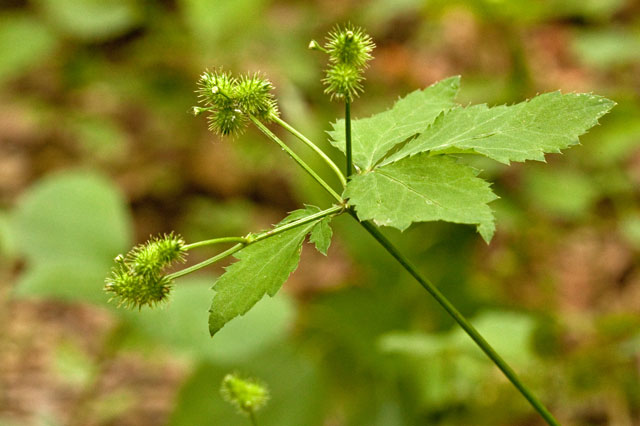 Large-fruited
snakeroot. July 17, 2009. Delaware County, Ohio.
As mentioned in the
sanicle/snakeroot essay
below, all
4 Ohio species of Sanicula
(family Apiaceae) look quite alike. But this plant immediately
stood out by virture of its young fruits being elliptical rather than
globose, and the hypanthium bristles seeming straighter (less hooked)
than the others. Back in the lab, reference to The Dicotyledoneae
of Ohio, Part 2 (Cooperrider, 1995) showed that a short-styles
Sanicula
with its comparatively few staminate flowers on relatively long
pedicles, bearing elliptical fruits that are sessile with a persistent
calyx that forms a persistent hard tuft at the fruit apex is
"large-ftuited snakeroot," S. trifoliata. The
species is found throughout Ohio. Below, a studio portrait displaying
those traits. 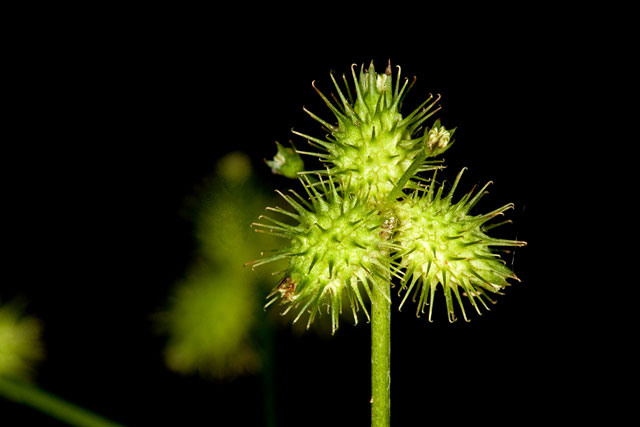 Sanicula trifoliata umbel. July 17, 2009. Note the persistent calyx forming a hard tuft. A tale of
two sanicles
Sanicula
gregaria and S. canadensis
June 19,
2009. Morral, Marion County, Ohio
The sanicles (also called "snakeroot," along with, it seems, about eleventy-seven other plants) are members of the genus Sanicula, in the wonderfully distinctive parsely family, Apiaceae. There are five Sanicula species in North America, four of which occur in Ohio. They tend to look alike. H. A. Gleason, in the best book ever written --The New Britton and Brown Ilustrated Flora of the Northeastern United States and Adjacent Canada (published in 1952 by the New York Botanical Garden) --explained "Our species are all glabrous and sparingly branched, 3-8 dm tall or rarely taller, and so alike in general habit that the existence of more than two species in our range was scarcely suspected until 1895." It's nice to be in good company, even if, as is most likely the case, the two species growing side-by-side at the Marion County Park District's Myer's Woods Preserve in Morral, Ohio are, by sanicle standards, the easiest to separate. By far the most abundant one here is "clustered snakeroot," Sanicula gregaria, widespread in the woods where it is shady. 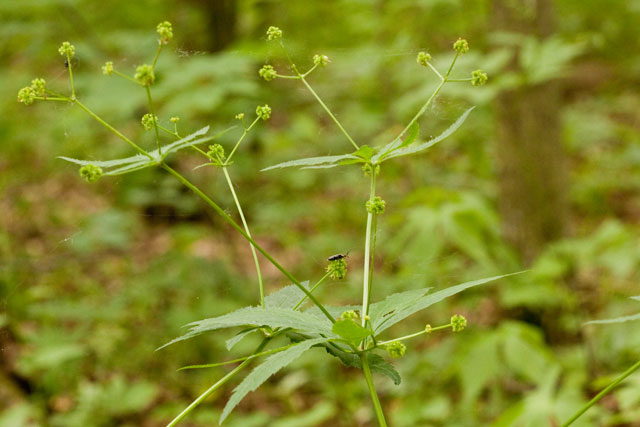 Clustered snakeroot. June 14, 2009. Myer's Woods, Marion County, Ohio. At the edge
of the
woods there is a sanicle (snakeroot, whatever) that looks a little
different --the branches are more ascending than wide-spreading, and
the flower clusters also seem a bit more compact. Moreover, they appear
to be a little earlier along, phenologically, as some of the flowers
still have petals. Subsequent study revealed this to be "short-styled
snakeroot," S. canadensis.
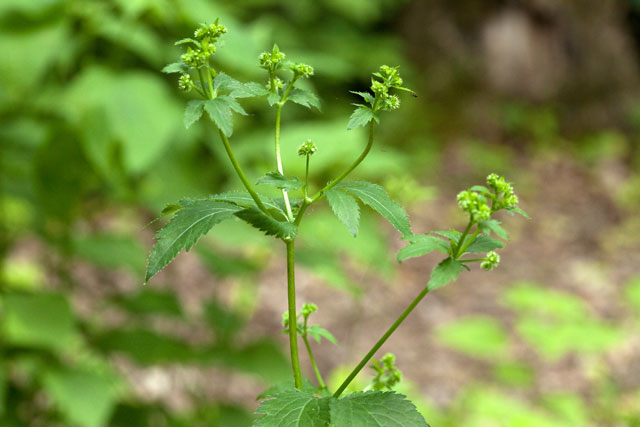 Short-styled snakeroot. June 19, 2009. Marion County, Ohio. Both Sanicula species display a leaf feature typical of the Apiaceae --deeply cleft leaves with an expanded base. (The leaf base wraps around the stem a bit, although that trait isn't evident here.) 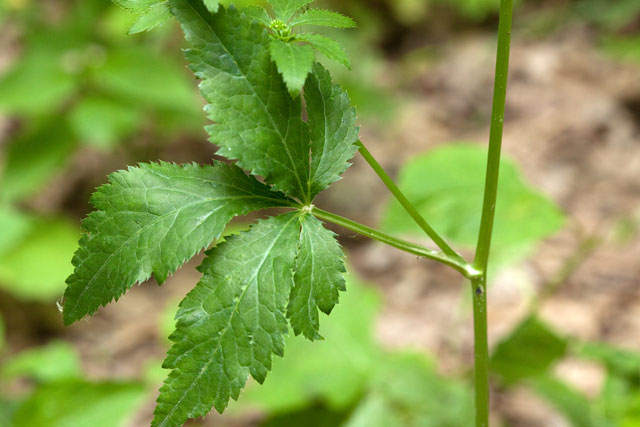 Short-styled snakeroot leaf. Marion County, Ohio. June 19, 2009. The hallmark
of the
Apiaceae, indeed why hence it is sometimes called the "Umbelliferae,"
is that the
inflorescence (flower cluster), is an umbel. An
umbel has all its flowers
attached at the same spot on the top of the flowering stem ("peduncle")
AND the flowers are individually stalked
(otherwise the inflorescence would be a head, not an umbel). A
signature example of an umbel (a
compound umbel, actually) is borne by Queen Anne's-lace (wild carrot).
At first
glance, snakeroot (sanicle, whatever) doesn't seem to have an umbel,
but
closer inspection reveals that it does.
Below, side-by-side, are the dense head-like simple umbels of our two most common species of sanicle (snakeroot, whatever). The genus displays another pecilarity: the flowers are of two types! Each umbel is composed of 3 sessile or (in this case) very short-pediceled "perfect" (hermaphroditic) flowers each with a bristly hypanthium covering the swollen inferior ovary, and mixed in are several-many staminate (male) flowers with smooth hypanthium, all or chiefly on long pedicels. 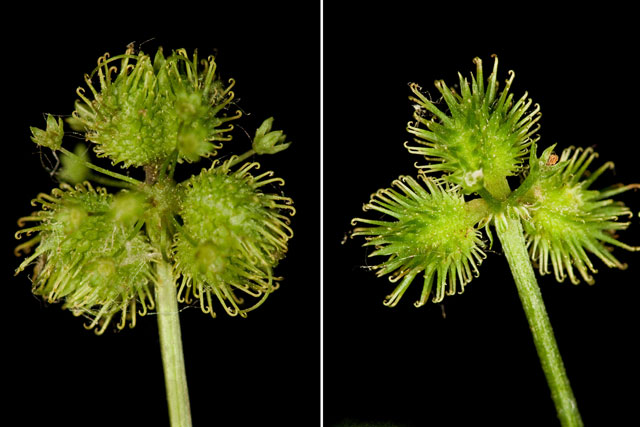 Fruiting umbels of sympatric Sanicula species. June 19, 2009. Marion County, Ohio. Left: S. gregaria. Right: S. canadensis. Diagnostic
features are
seen on both types of flowers. When the perfect
flowers of S. gregaria develop into
fruit, the two styles are longer than the bristles of the fruit,
recurved-spreading and conspicuous, whereas those of the aptly
(common) named S. canadensis --"short-styled
snakeroot" --are so short they just seem lost among all those
bristles. Meanwhile the staminate flowers of S.
gregaria are abundant --10-20 in number, and their sepals (calyx
lobes) have a broad triangular shape. Contrast these guys with the male
flowers of S. canadensis, which are much fewer in
number (only 1-5),
and have narrowly awl-shaped calyx lobes.
Below, an photographic explication of the diagnostic features of the two snakeicle (sanroot, whatever) species. First, see the style length feature that is evident on the perfect flowers. Then,
please MOUSEOVER
the IMAGE to see staminate flower
traits.
Distinguishing
features of co-occurring Sanicula species. Marion
County, Ohio.
Hello,
911? I'd like to report a
robbery!
Carpenter
bee on foxglove beard-tongue.
June 19,
2009. Marion, Ohio.
Is this
really an
emergency? I don't think so! Anyhow, flowers are exquisitely
constructed to maneuver visiting insects in a manner that fosters the
removal and deposition of pollen. However, some nectar-feeding insects
find it easier to circumvent the flower's design. Each June, a stand of
foxglove beard-tongue (Penstemon digitalis, family
Scrophulariaceae) at the Larry R. Yoder Prairie at the OSU-Marion
campus is visited by carpenter bees, honeybees, and
bumblebees. They tend to behave differently with respect to how they
exploit the flowers. Most strikingly, the carpenter bees totally
short-circuit the flower's "plan" by piercing a slit at the base of the
corolla and drinking nectar directly through it, with no apparent
benefit to the
plant.
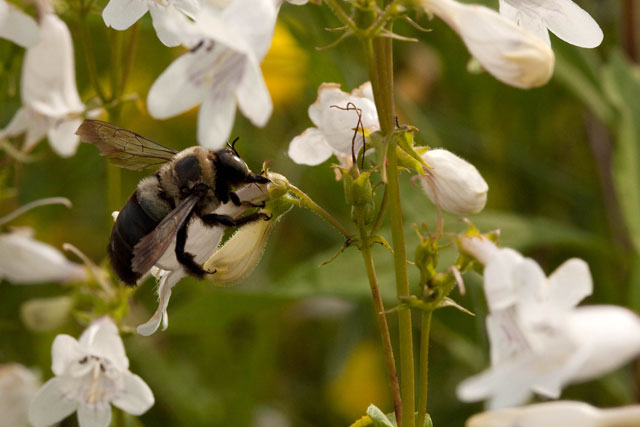 Carpenter bee robbing nectar at Larry R. Yoder Prairie. June 19, 2009. Here are 820
more
pictures of
this, displayed successively, 1/30 second per
picture. Each
photo is slightly different than the previous one, and they seem to
blend together.
Carpenter
bee robbing
nectar from Penstemon digitalis. June 29, 2009.
Like looters
entering a
store after
somebody else has initially broken into it, honeybees acts as
"secondary theives," drinking nectar through slits made by the
carpenter bees.
Honeybee driking nectar through slits cut by carpenter bee. June 19, 2009. Marion, Ohio. Playing "Gallant" to Carpenter Bee's "Goofus," most (but not all) of the time the bumblebees are doing the right thing, entering the flower through its throat, thereby potentially effecting pollination. Bumblebee "legitimately" forages on foxglove beardtongue in Marion, Ohio. |
